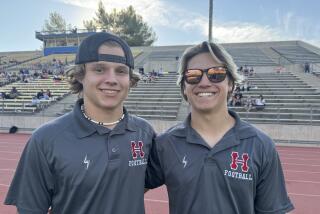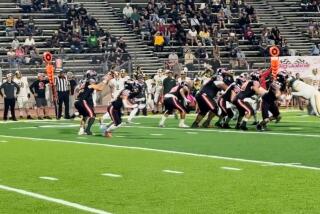Experts Question Hart Safety Precautions
- Share via
NEWHALL — With more details coming out about the death of a young Valencia pole vaulter, track and field experts are questioning safety precautions at the scene of the accident.
Heath Taylor, 17, had completed a routine vault when he landed near the back of the mat and bounced off, striking his head on asphalt during practice Tuesday at Hart High.
Thursday, a reporter overheard a Hart assistant coach and a team member discussing the incident during a dual meet at Burroughs. They said Taylor showed good form early in the jump, then seemed to catapult forward. Both expressed surprise at how far Taylor’s vault carried.
Hart administrators have been reluctant to discuss details of the accident and have shielded coaches and athletes from speaking to the media.
“It is true that [Taylor] landed in the back part of the pit and then went off the end of the mat,” Hart Principal Laurence Strauss said. Strauss also confirmed that the assistant coach and athlete witnessed the accident.
The Los Angeles County Coroner’s office said Taylor’s death from severe head trauma was accidental. State and national track officials want to know more about Hart’s safety equipment.
The school’s landing mat, measuring 20 by 22 feet, exceeded the safety standards published by the National Federation of State High School Assns. But the federation also recommends that any “hard or unyielding surfaces” adjacent to the mat be covered with “two-inch dense foam or other suitable material.”
The Hart pole vault area has asphalt runways leading to the pit from opposite directions, so the event can be shifted in case of strong winds. Taylor hit his head on the opposite runway.
“It seems like they had a good-sized pit but there have been instances where people have stumbled getting out of the pit [after a jump] and fallen off and conked their heads,” said Jan Johnson, a safety official with the USA Track and Field Assn. “That’s why the federation rules say that hard surfaces should be padded.”
Johnson recently reviewed the March 7 death of a Chicago Heights vaulter who overshot the pit and landed headfirst on the ground. In that case, he said, there was insufficient padding around the mat.
Of the Hart incident, another track expert who asked not to be identified said: “They were stupid.”
Hart administrators have said only that, as far as they knew, the landing pit was safe. The school is preparing an incident report for its district office.
In the meantime, track experts question how Taylor’s jump could have gone so wrong.
Pole vault ranks as the most dangerous event in the sport, having accounted for nine of 11 deaths in high school track and field from 1982-94. In recent years, the federation has responded with numerous safety standards.
In addition to asking for extra padding around the pit, it recommended that vaulters use appropriately stiff poles. Taylor, who weighed between 135 and 140 pounds, was using a pole rated for athletes 150 pounds or lighter, Hart administrators said.
“Before the rule, kids were using light poles and that was dangerous because they could break the poles,” said Brian Springer, a former high school coach who sells track equipment. “Now it’s safer. A good vaulter will be vaulting on a pole that is rated much higher than his weight.”
Given the fact that Taylor was using an appropriate pole to jump only 10 feet--1 1/2 feet below his personal best--track experts wondered why he carried so far. Johnson said that Taylor’s death could have resulted from a extraordinarily well-executed effort.
“He may have just run down the runway and, on that one occasion, got off one heck of a plant and take-off,” said Johnson, a bronze medalist in the pole vault in the 1972 Olympics. “As you leave the ground with more energy, you must jump with a stiffer pole. He may have overpowered his pole.”
Hart’s incident report could provide answers. The California Interscholastic Federation and the USA Track and Field Assn. will ask for a copy of the findings.
Both organizations will look for rule changes that could prevent future accidents. Officials could push for the use of lightweight helmets like the one worn by Stanford freshman pole vaulter Toby Stevenson.
“High school kids are just learning and sometimes they are pushing themselves too hard,” said Stevenson, a former Texas high school champion. “They don’t know where they are in the air. They don’t know how to land.”
Said Springer: “You talk to anyone in track and they’ll tell you that pole vaulters are the craziest. Fear is not even in their minds. It’s the thrill of riding that pole up there.”
Johnson runs a junior pole vaulting club in Atascadero, where this week the athletes voted to wear helmets in the upcoming CIF sectional finals.
“We had a lot of accidents in the ‘80s and early ‘90s and then we changed the rules,” Johnson said. “Now we’ve got to look at this very closely again.”
More to Read
Go beyond the scoreboard
Get the latest on L.A.'s teams in the daily Sports Report newsletter.
You may occasionally receive promotional content from the Los Angeles Times.











